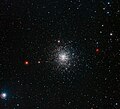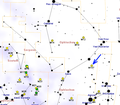Messier 107
| Messier 107 | |
|---|---|
′[5] | |
| Physical characteristics | |
| Mass | 1.82×105[3] M☉ |
| Radius | 30 ly[6] |
| Metallicity | = –0.95 Gyr[7] |
| Other designations | C 1629-129, GCl 44, M 107, NGC 6171[8] |
Messier 107 or M107, also known as NGC 6171 or the Crucifix Cluster, is a very loose
Observational history, namings and guide
It was discovered by Pierre Méchain in April 1782, then independently by William Herschel in 1793. Herschel's son, John, in his 1864 General Catalogue, described it as a "globular cluster of stars, large, very rich, very much compressed, round, well resolved, clearly consisting of stars".[5] It was not until 1947 that Helen Sawyer Hogg added it and three other objects found by Méchain to the modern Catalogue, the latter having contributed several of the suggested observation objects which Messier had verified and added.[9] The cluster is to be found 2.5° south and slightly west of the star Zeta Ophiuchi.[5]
Properties
M107 is close to the galactic plane and about 20,900 light-years from Earth[3] and 9,800 ly (3,000 pc) from the Galactic Center.[10] Its orbit is partly as far out as the galactic halo, as is between 9,200–12,400 ly (2,820–3,790 pc) from the Galactic Center, the lower figure, the "perigalactic distance" sees it enter and leave the galactic bar.[11]
It is an
Gallery
-
The globular star cluster Messier 107 image taken by the Wide Field Imager (WFI) on the MPG/ESO 2.2-metre telescope.
-
Map showing the location of M107.
See also
- List of Messier objects
References and footnotes
- Bibcode:1927BHarO.849...11S.
- ^ S2CID 119183070.
- ^ S2CID 118649860.
- ^ "Messier 107". SEDS Messier Catalog. Retrieved 30 April 2022.
- ^ ISBN 978-0387681252.
- ^ From trigonometry: distance × sin( diameter_angle / 2 ) = 39.5 ly. radius
- ^ S2CID 51825384.
- ^ "NGC 6171". SIMBAD. Centre de données astronomiques de Strasbourg. Retrieved 2006-11-16.
- ^ Frommert, Hartmut; Kronberg, Christine (August 30, 2007), "Messier 107", SEDS Messier pages, Students for the Exploration and Development of Space (SEDS), retrieved 2018-12-07.
- ^ doi:10.1086/163249.
- S2CID 16356464.
- S2CID 14453719.
- Bibcode:2013AAS...22125022M, 250.22.
- ^ Where minus 1 would be 10 times less iron-to-hydrogen metallicity than the Sun
External links

![{\displaystyle {\begin{smallmatrix}\left[{\ce {Fe}}/{\ce {H}}\right]\end{smallmatrix}}}](https://wikimedia.org/api/rest_v1/media/math/render/svg/4c0821bd80891e071c08e7c7ee8e022baedf522c)


